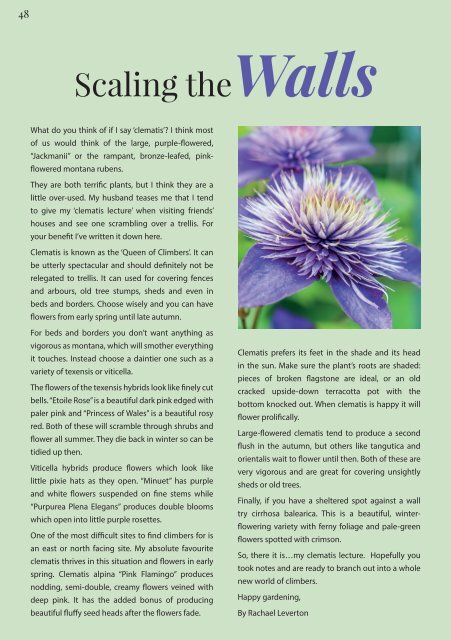Local Life - St Helens - May 2019
St Helens' FREE local lifestyle magazine.
St Helens' FREE local lifestyle magazine.
- No tags were found...
Create successful ePaper yourself
Turn your PDF publications into a flip-book with our unique Google optimized e-Paper software.
48<br />
Scaling theWalls<br />
What do you think of if I say ‘clematis’? I think most<br />
of us would think of the large, purple-flowered,<br />
“Jackmanii” or the rampant, bronze-leafed, pinkflowered<br />
montana rubens.<br />
They are both terrific plants, but I think they are a<br />
little over-used. My husband teases me that I tend<br />
to give my ‘clematis lecture’ when visiting friends’<br />
houses and see one scrambling over a trellis. For<br />
your benefit I’ve written it down here.<br />
Clematis is known as the ‘Queen of Climbers’. It can<br />
be utterly spectacular and should definitely not be<br />
relegated to trellis. It can used for covering fences<br />
and arbours, old tree stumps, sheds and even in<br />
beds and borders. Choose wisely and you can have<br />
flowers from early spring until late autumn.<br />
For beds and borders you don’t want anything as<br />
vigorous as montana, which will smother everything<br />
it touches. Instead choose a daintier one such as a<br />
variety of texensis or viticella.<br />
The flowers of the texensis hybrids look like finely cut<br />
bells. “Etoile Rose” is a beautiful dark pink edged with<br />
paler pink and “Princess of Wales” is a beautiful rosy<br />
red. Both of these will scramble through shrubs and<br />
flower all summer. They die back in winter so can be<br />
tidied up then.<br />
Viticella hybrids produce flowers which look like<br />
little pixie hats as they open. “Minuet” has purple<br />
and white flowers suspended on fine stems while<br />
“Purpurea Plena Elegans” produces double blooms<br />
which open into little purple rosettes.<br />
One of the most difficult sites to find climbers for is<br />
an east or north facing site. My absolute favourite<br />
clematis thrives in this situation and flowers in early<br />
spring. Clematis alpina “Pink Flamingo” produces<br />
nodding, semi-double, creamy flowers veined with<br />
deep pink. It has the added bonus of producing<br />
beautiful fluffy seed heads after the flowers fade.<br />
Clematis prefers its feet in the shade and its head<br />
in the sun. Make sure the plant’s roots are shaded:<br />
pieces of broken flagstone are ideal, or an old<br />
cracked upside-down terracotta pot with the<br />
bottom knocked out. When clematis is happy it will<br />
flower prolifically.<br />
Large-flowered clematis tend to produce a second<br />
flush in the autumn, but others like tangutica and<br />
orientalis wait to flower until then. Both of these are<br />
very vigorous and are great for covering unsightly<br />
sheds or old trees.<br />
Finally, if you have a sheltered spot against a wall<br />
try cirrhosa balearica. This is a beautiful, winterflowering<br />
variety with ferny foliage and pale-green<br />
flowers spotted with crimson.<br />
So, there it is…my clematis lecture. Hopefully you<br />
took notes and are ready to branch out into a whole<br />
new world of climbers.<br />
Happy gardening,<br />
By Rachael Leverton


















